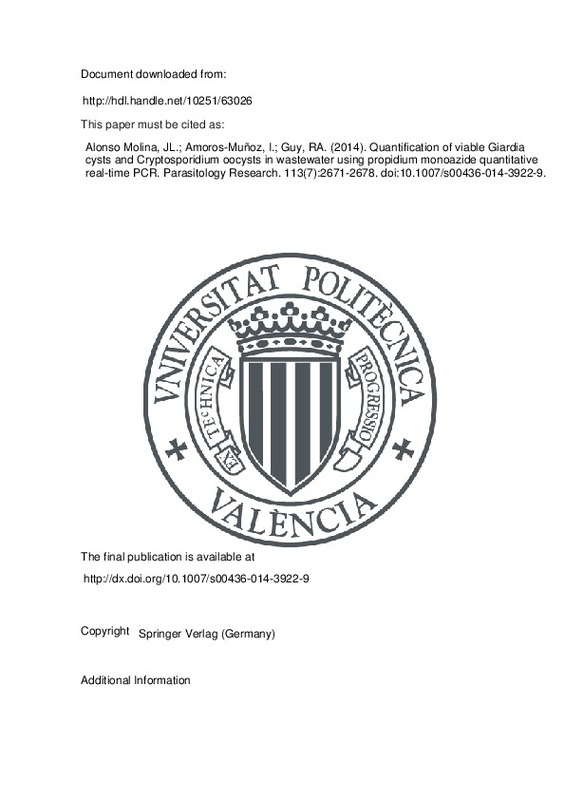Agulló-Barceló M, Moss JA, Green J, Gillespie S, Codony F, Lucena F, Nocker A (2014) Quantification of relative proportions of intact cells in microbiological samples using the example of Cryptosporidium parvum oocysts. Lett Appl Microbiol 58:70–78
Agusti G, Codony F, Fittipaldi M, Adrados B, Morató J (2010) Viability determination of Helicobacter pylori using propidium monoazide quantitative PCR. Helicobacter 15:473–476
Almeida A, Pozio E, Cacciò SM (2010) Genotyping of Giardia duodenalis cysts by new real-time PCR assays for detection of mixed infections in human samples. Appl Environ Microbiol 76:1895–1901
[+]
Agulló-Barceló M, Moss JA, Green J, Gillespie S, Codony F, Lucena F, Nocker A (2014) Quantification of relative proportions of intact cells in microbiological samples using the example of Cryptosporidium parvum oocysts. Lett Appl Microbiol 58:70–78
Agusti G, Codony F, Fittipaldi M, Adrados B, Morató J (2010) Viability determination of Helicobacter pylori using propidium monoazide quantitative PCR. Helicobacter 15:473–476
Almeida A, Pozio E, Cacciò SM (2010) Genotyping of Giardia duodenalis cysts by new real-time PCR assays for detection of mixed infections in human samples. Appl Environ Microbiol 76:1895–1901
Alonso JL, Amorós I, Cañigral I (2011) Development and evaluation of a real-time PCR assay for quantification of Giardia and Cryptosporidium in sewage samples. Appl Microbiol Biotechnol 89:1203–1211
Baldursson S, Karanis P (2011) Waterborne transmission of protozoan parasites: a review of worldwide outbreaks—an update 2004–2010. Water Res 45:6603–6614
Baque RH, Gilliam AO, Robles LD, Jakubowski W, Slifko TR (2011) A real-time RT-PCR method to detect viable Giardia lamblia cysts in environmental waters. Water Res 45:3175–3184
Belosevic M, Guy RA, Taghi-Kilani R, Neumann NF, Gyürek LL, Liyanage LRJ, Millards PJ, Finch GR (1997) Nucleic acid stains as indicators of Cryptosporidium parvum oocyst viability. Int J Parasitol 27:787–798
Brescia CC, Griffin SM, Ware MW, Varughese EA, Egorov AI, Villegas EN (2009) Cryptosporidium propidium monoazide-PCR, a molecular biology-based technique for genotyping of viable Cryptosporidium oocysts. Appl Environ Microbiol 75:6856–6863
Cacciò SM, De Giacomo M, Aulicino FA, Pozio E (2003) Giardia cysts in wastewater treatment plants in Italy. Appl Environ Microbiol 69:3393–3398
Contreras PJ, Urrutia H, Sossa K, Nocker A (2011) Effect of PCR amplicon length on suppressing signals from membrane-compromised cells by propidium monoazide treatment. J Microbiol Methods 87:89–95
Fittipaldi M, Rodriguez NJ, Codony F, Adrados B, Peñuela GA, Morató J (2010) Discrimination of infectious bacteriophage T4 virus by propidium monoazide real-time. J Virol Methods 168:228–232
Fittipaldi M, Rodriguez NJ, Adrados B, Agustí G, Peñuela G, Morató J, Codony F (2011) Discrimination of viable Acanthamoeba castellani trophozoites and cysts by propidium monoazide real-time polymerase chain reaction. J Eukaryot Microbiol 58:359–364
Fittipaldi M, Nocker A, Codony F (2012) Progress in understanding preferential detection of live cells using viability dyes in combination with DNA amplification. J Microbiol Methods 91:276–289
Guy RA, Payment P, Krull UJ, Horgen PA (2003) Real-time PCR for quantification of Giardia and Cryptosporidium in environmental water samples and sewage. Appl Environ Microbiol 69:5178–5185
Guy RA, Kapoor A, Holicka J, Shepherd D, Horgen PA (2006) A rapid molecular-based assay for direct quantification of viable bacteria in slaughterhouses. J Food Protect 69:1265–1272
Liang Z, Keeley A (2012) Comparison of propidium monoazide-quantitative PCR and reverse transcription quantitative PCR for viability detection of fresh Cryptosporidium oocysts following disinfection and after long-term storage in water samples. Water Res 46:5941–5953
Liu A, Ji H, Wang E, Liu J, Xiao L, Shen Y, Li Y, Zhang W, Ling H (2011) Molecular identification and distribution of Cryptosporidium and Giardia duodenalis in raw urban wastewater in Harbin, China. Parasitol Res 109:913–918
Nocker A, Camper AK (2009) Novel approaches toward preferential detection of viable cells using nucleic acid amplification techniques. FEMS Microbiol Lett 291:137–142
Nocker A, Cheung C-Y, Camper AK (2006) Comparison of propidium monoazide with ethidium monoazide for determination of live vs. dead bacteria by selective removal of DNA from dead cells. J Microbiol Methods 67:310–320
Opel KL, Chun D, McCord BR (2010) A study of PCR inhi-bition mechanisms using real time PCR. J Forensic Sci 55:25–33
Reynolds KA, Mena KD, Gerba CP (2008) Risk of waterborne illness via drinking water in the United States. Rev Environ Contam Toxicol 192:117–158
Robertson LJ, Casaert S, Valdez-Nava Y, Ehsan MA, Claerebout E (2014) Drying of Cryptosporidium oocysts and Giardia cysts to slides abrogates use of vital dyes for viability staining. J Microbiol Methods 96:68–69
Smith AL, Smith HV (1989) A comparison of fluorescein diacetate and propidium iodide staining and in vitro excystation for determining Giardia intestinalis cyst viability. Parasitology 99:329–331
Smith HV, Cacciò SM, Cook N, Nichols RAB, Tait A (2007) Cryptosporidium and Giardia as foodborne zoonoses. Vet Parasitol 149:29–40
Sulaiman IM, Fayer R, Bern C, Gilman RH, Trout JM, Schantz PM, Das P, Lal AA, Xiao L (2003) Triosephosphate isomerase gene characterization and potential zoonotic transmission of Giardia duodenalis. Emerg Infect Dis 9:1444–1452
Sulaiman IM, Jiang J, Singh A, Xiao L (2004) Distribution of Giardia duodenalis genotypes and subgenotypes in raw urban wastewater in Milwaukee, Wisconsin. Appl Environ Microbiol 70:3776–3780
Vesper S, McKinstry C, Hartmann C, Neace M, Yoder S, Vesper A (2008) Quantifying fungal viability in air and water samples using quantitative PCR after treatment with propidium monoazide (PMA). J Microbiol Methods 72:180–184
[-]







![[Cerrado]](/themes/UPV/images/candado.png)


